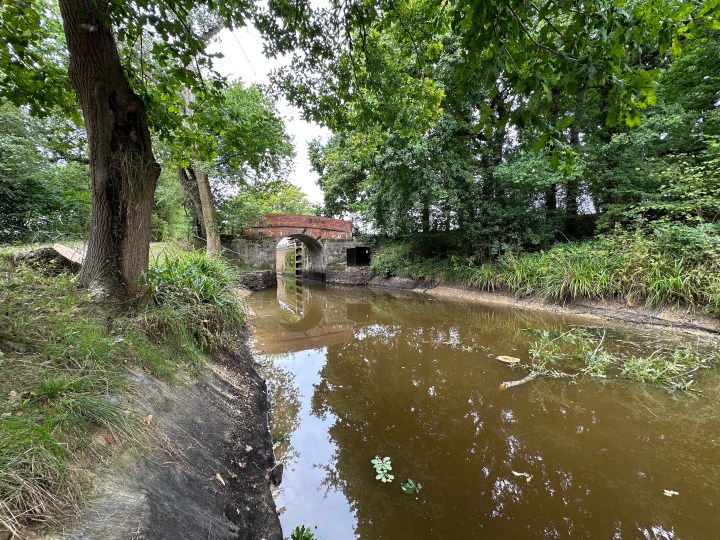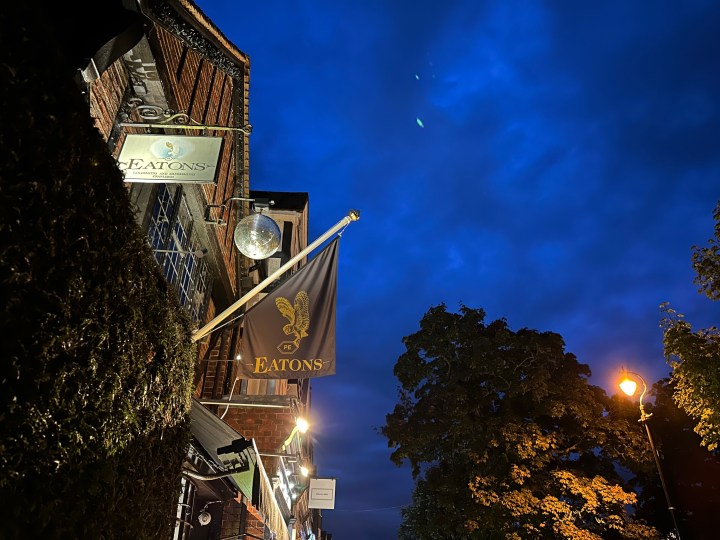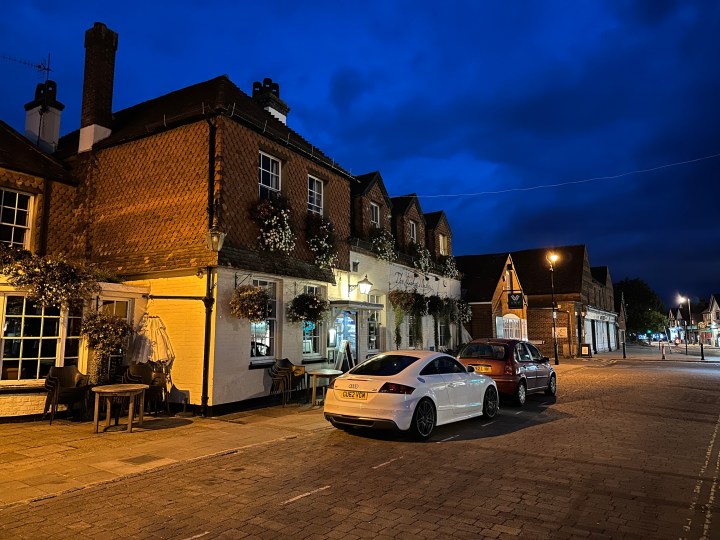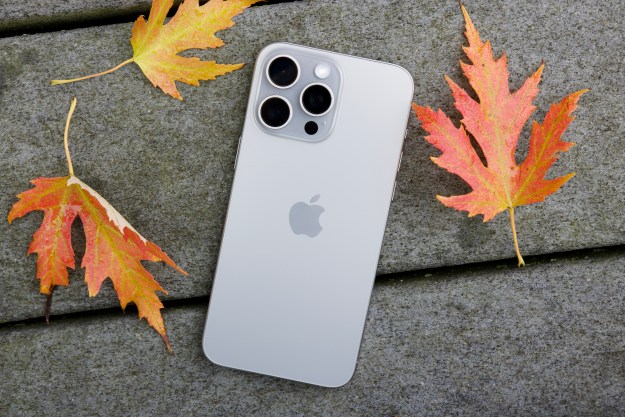The iPhone 14 Pro and the Samsung Galaxy Z Flip 4 are very different smartphones. Try to fold the iPhone like the Z Flip 4, and it’ll all end in tears. Yet if you’ve got $1,000 to spend, these two sit alongside each other on the shelves, and that makes comparing them an interesting proposition. Both are very tempting, just for different reasons. Can the camera performance help make any decision easier?
- iPhone 14 Pro vs Galaxy Z Flip 4: camera specs
- iPhone 14 Pro vs Galaxy Z Flip 4: main camera
- iPhone 14 Pro vs Galaxy Z Flip 4: wide-angle camera
- iPhone 14 Pro vs Galaxy Z Flip 4: telephoto camera
- iPhone 14 Pro vs Galaxy Z Flip 4: Night mode
- iPhone 14 Pro vs Galaxy Z Flip 4: portrait mode
- iPhone 14 Pro vs Galaxy Z Flip 4: selfie camera
- Which one should get your $1,000?
iPhone 14 Pro vs Galaxy Z Flip 4: camera specs
A pair of 12-megapixel cameras live on the back of the Galaxy Z Flip 4, both covering the main and wide-angle duties. The main camera has optical image stabilization and an f/1.8 aperture, while the wide-angle camera has a 123-degree field of view. There’s no telephoto camera, but Samsung provides a 10x digital zoom feature. However, it doesn’t make it a big deal and has not added a shortcut to the camera app.
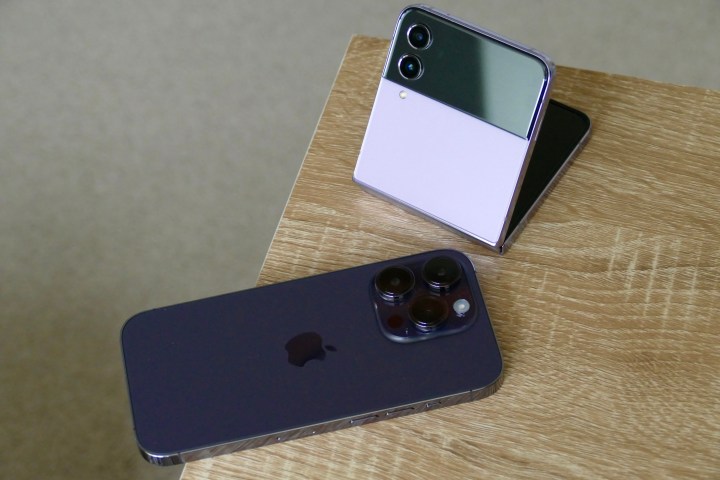
The iPhone 14 Pro has a 48MP main camera with its second-generation optical image stabilization and an f/1.78 aperture, which is joined by a 12MP wide-angle camera and a 12MP telephoto with 2x and 3x optical zoom. On the software side, Apple loads its new Photonic Engine, plus Deep Fusion and Smart HDR 4 features. The 12MP selfie camera also makes use of these features, while the Samsung phone has a 10MP f/2.4 camera at the top of the screen.
On paper, the iPhone 14 Pro has the more impressive specification, and the optical zoom feature will make it more versatile. Can this apparent superiority carry across to a decisive win? All the photos below were taken using the automatic settings across several different days. All have been examined on a color-calibrated monitor, then resized before uploading here.
iPhone 14 Pro vs Galaxy Z Flip 4: main camera
The main camera test results show the iPhone 14 Pro isn’t going to have the test all to itself, as the Z Flip 4 takes some really great photos. Perhaps not technically as good, but with its recent phones, Samsung has got the level of saturation and pop just right — taking very shareable photos that instantly appeal.
- 1. Apple iPhone 14 Pro
- 2. Samsung Galaxy Z Flip 4
The photo of the car illustrates what I mean. The iPhone 14 Pro’s photo is more realistic, has more accurate colors, and has better exposure. But there’s a lot more visual punch to the Z Flip 4’s photo, with brighter colors and more saturation. Zoom in, and the level of detail in each is similar, but the Z Flip 4 loses out on the intricate textures seen in the iPhone’s photo.
- 1. Apple iPhone 14 Pro
- 2. Samsung Galaxy Z Flip 4
Take a look at the photo of the canal too, where the grass is more vibrant in the Z Flip 4’s photo, and the sky less oppressive. The iPhone 14 Pro’s picture is closer to what I saw with my own eyes, but it doesn’t have that Samsung pop. The iPhone’s photo is obviously technically superior, but that doesn’t always matter when you want to quickly share the photo.
- 2. Samsung Galaxy Z Flip 4
Finally, the photo of the flowers shows where the Galaxy Z Flip 4’s love of bright colors and over-exposure really hurts the final image. While I like the brightness showing the texture of the brickwork and the basket, the flowers were red and not orange, making this a very different scene from real life. The iPhone 14 Pro’s consistent natural tones and balanced colors mean it always delivers a strong photo, and I love the depth of field it generated.
The Galaxy Z Flip 4’s camera can take excellent photos, and I’ve found most very easy to share without a second thought, but the iPhone 14 Pro’s consistency and realism have to win through.
Winner: Apple iPhone 14 Pro
iPhone 14 Pro vs Galaxy Z Flip 4: wide-angle camera
The wide-angle camera tells a similar story. The Z Flip 4 produces bright, colorful photos that aren’t particularly subtle when looked at alongside the iPhone 14 Pro’s natural, understated pictures. The iPhone’s photo of the bridge over the canal is atmospheric with a natural look, but at the expense of a blown-out sky. The Z Flip 4’s vibrant greens overpower the image.
- 2. Samsung Galaxy Z Flip 4
There’s less edge distortion in the iPhone’s wide-angle photo, and very little of the stretching seen in the Z Flip 4’s picture, especially in the tree trunk. This lack of distortion is also visible in the photo of the church, where the grass remains normal-looking in the iPhone’s picture but stretched and blurred in the Z Flip 4’s. It should be noted the Z Flip 4’s wide-angle camera has a greater field of view. Obviously, the treatment of the sky is different too, and a return to the Samsung phone’s love of producing a vibrant and exciting photo at the expense of realism.
- 1. Apple iPhone 14 Pro
- 2. Samsung Galaxy Z Flip 4
The last photo here shows once again where the Z Flip 4’s camera can produce eye-catching photos where realism doesn’t really matter. The sign is readable, the greenery colorful, and although it could do with toning down a bit, the scene is far more attractive than the iPhone’s dull, almost wintery look.
The iPhone 14 Pro will take the win due to the lack of distortion and, more often than not, getting the tone of the scene right, but the photos won’t be to everyone’s taste. That’s where the Z Flip 4 comes in, and its main and wide-angle cameras really do provide an alternative to the iPhone, despite not being as technically adept.
Winner: Apple iPhone 14 Pro
iPhone 14 Pro vs Galaxy Z Flip 4: telephoto camera
Only one example is required to see the difference between the iPhone 14 Pro’s 3x optical zoom and the Z Flip 4’s 3x digital zoom. This isn’t a fair fight, and to give Samsung credit, it hasn’t added a quick shortcut to a digital 3x zoom in the viewfinder — so it really doesn’t want you to start zooming in.
- 1. Apple iPhone 14 Pro
- 2. Samsung Galaxy Z Flip 4
There’s good reason because the photos it takes aren’t very good. The bridge is recognizable and the colors are fine, plus it’s exposed effectively enough, but the overall image is pixelated and noisy. It’s very clear the photo has been taken with a digital zoom. The iPhone 14 Pro’s telephoto camera is probably its best, or most improved, camera over the previous generation phone and the photos it takes are superb. Little else needs to be said, apart from don’t use the Z Flip 4’s digital zoom if you want good photos.
Winner: Apple iPhone 14 Pro
iPhone 14 Pro vs Galaxy Z Flip 4: Night mode
Night mode is where the test gets really interesting, as both have distinct strengths and weaknesses. The first photo shows where the Z Flip 4 can sometimes win over the iPhone 14 Pro, with a sharper, less noisy photo. The flag and the glitter ball are more defined, the brickwork has a sharpness missing from the iPhone’s photo, and it’s somewhat brighter too.
- 2. Samsung Galaxy Z Flip 4
But the second photo shows where the Samsung phone falls down, with a warmer image that isn’t as well balanced as the iPhone’s photo, and really shows where the Z Flip 4 relies on smoothing in some of its Night mode shots. The iPhone avoids all this with excellent white balance, less noise, more texture, and a more realistic overall tone.
- 2. Samsung Galaxy Z Flip 4
These results tracked across most lowlight photos, and it seemed to come down to the amount of light available. The iPhone preferred darker conditions, but give the Z Flip 4 just a little more light, and the photos are much better. Neither has perfect photos, so this one is a draw. However, I’d expect Apple to improve its Night mode through software updates soon, due to its recent release, and it may take Samsung a little longer to enhance the camera.
Winner: Draw
iPhone 14 Pro vs Galaxy Z Flip 4: portrait mode
The Galaxy Z Fold 4’s portrait mode is far better at isolating objects, dealing with short distances, and has a better understanding of what should bein in focus and what shouldn’t. It’s more versatile than the iPhone’s portrait mode, which seems to prefer to find faces and not objects. That’s fine, but I prefer being able to use the mode for everything, not just people.
- 1. Apple iPhone 14 Pro
- 2. Samsung Galaxy Z Flip 4
This simple photo of the Apple Watch SE 2 on my wrist illustrates where the iPhone 14 Pro gets it wrong so often. It can’t seem to isolate everything as the Z Flip 4 does, which even manages to get my arm hair into the foreground. I far prefer the warmer tone too. And when I took these shots, the Samsung phone recognized my arm and watch instantly, while the iPhone repeatedly asked me to move further away from the subject before it locked on.
- 1. Apple iPhone 14 Pro
- 2. Samsung Galaxy Z Flip 4
The second photo of the padlock and gate highlights how good the Z Flip 4’s portrait mode can be. The entire chain is in focus, as is the U-shaped bolt above it, while the wood fades into the background very effectively. It’s a photo you could share happily due to its natural look. The iPhone 14 Pro simply can’t compete, and looks obviously “fake.”
Winner: Samsung Galaxy Z Flip 4
iPhone 14 Pro vs Galaxy Z Flip 4: selfie camera
The Galaxy Z Flip 4’s selfie camera may have fewer megapixels, but it has the iPhone 14 Pro beaten in this category. I’ve been consistently impressed with the selfies taken by the Z Flip 4, which captures my skin tone in a way that I like, introduces plenty of detail, and is very effective in low light. This is a surprise, as the iPhone is supposed to fall back on the Photonic Engine here, something it does well with the 3x zoom using the rear camera in low light.
- 1. Apple iPhone 14 Pro
- 2. Samsung Galaxy Z Flip 4
Selfies taken with the Z Flip 4 still have problems, though. The edge recognition in portrait mode isn’t as good as the iPhone’s, and colors are often a little less realistic, but I’ll take those when the photo of me is more visually pleasing to my eye. I also like the Z Flip 4’s editing suite for selfies, with its slick background changes and adjustable light source when you select the Studio setting.
Plus, you can use the Z Flip 4’s Cover screen to take selfies with the rear cameras, the phone folds to create a handy stand so you can take selfies without holding the phone, and Samsung’s palm gesture to activate the shutter makes all of this very easy. It’s by far the better phone for selfies.
Winner: Samsung Galaxy Z Flip 4
Which one should get your $1,000?
It’s surprisingly close. The Apple iPhone 14 Pro won three categories, the Galaxy Z Flip 4 took two wins, and the pair had a single draw. If forced to pick a winner of the Night mode category it would be the
So which one should you buy? Leaving the cameras aside for a moment, remember only one of these phones folds up, and it’s a huge selling point. The Z Flip 4 is so compact when folded, yet completely normal when unfolded. This design has been tied into the camera’s functionality, too, making it a genuinely fun camera phone.
It’s the best way to look at these two $1,000 phones. Both are two of the best phones you can buy, but there’s a distinct difference in their character. The Z Flip 4 always feels fun and exciting, and the photos it takes reflect that. The iPhone 14 Pro is a more serious device, and its photos will please those who demand quality and realism. Before you go off to buy one, make sure you take a look at our comparison between the iPhone 13 Pro’s camera and the iPhone 14 Pro, where the results are quite different again.
Editors' Recommendations
- Nomad’s new iPhone case and Apple Watch band may be its coolest yet
- iPhone 16: news, rumored price, release date, and more
- iPhone SE 4: news, rumored price, release date, and more
- This is our best look yet at the iPhone 16’s big design changes
- I’ve had the iPhone 15 Pro for six months. Here’s why it’s still amazing







